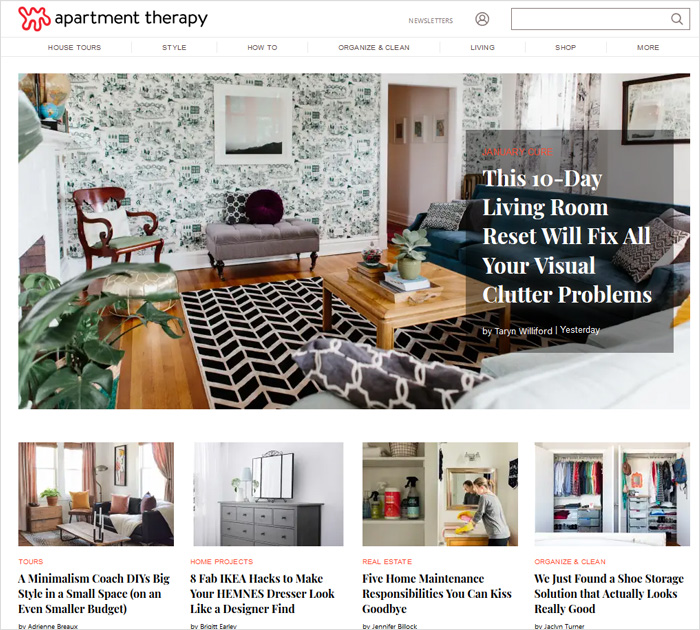How to start a craft blog

If you’re a creator looking to make money with your crafts, starting a craft blog is like opening a window to your creative world and inviting customers to step inside. It's your platform to showcase your craft expertise, share DIY tutorials and connect with fellow craft enthusiasts.
Not only can you demonstrate your craftsmanship, but you can also offer a behind-the-scenes look into your creative process, making your products even more appealing. Your craft blog can attract a dedicated audience who appreciates your handmade creations and can become loyal customers
So, if you're passionate about crafting and want to take your craft business to the next level, start a blog and watch your creative journey unfold.
Why should you start a craft blog?
A craft blog offers a space where you can showcase your creativity, connect with a like-minded community and establish yourself as an authority in your crafting niche. This type of blog can serve as your craft business's online identity, introducing your store to audiences all over the world. As your blog grows, you can enjoy the benefits of funneling more traffic to your business website, entirely for free. You can additionally monetize your blog through ads, sponsored content or digital product sales, creating an additional income stream.
How to start a craft blog in 6 steps
Here's a simplified roadmap in six essential steps to ignite your crafting passion:
- Choose a craft niche to blog about
- Select a blog maker
- Find the right name and domain for your blog
- Plan and publish blog content
- Promote your craft blog
- Monetize your craft blog
01. Choose a craft niche to blog about
When it comes to choosing a blog niche, it’s best to start with what you know. With so many potential topics to cover, it's essential to choose a niche or craft business idea that aligns with your interests and appeals to your target audience. Here are five craft blog examples, including their niche and blog types, that you could consider pursuing:
- DIY tutorials and how-to guides. Blog niche: providing step-by-step tutorials and guides for various craft projects. Types of blog posts: detailed DIY tutorials, crafting techniques, crafting hacks and project breakdowns.
- Handmade business tips and insights. Blog niche: sharing business advice, strategies and insights for fellow craft entrepreneurs. Types of blog posts: marketing tips, pricing strategies, branding advice and success stories.
- Craft supplies reviews and recommendations. Blog niche: reviewing and recommending various craft supplies, tools and materials. Types of blog posts: product reviews, comparisons, crafting tool guides and best-of lists.
- Seasonal and holiday crafts. Blog niche: focusing on crafts related to different seasons, holidays and celebrations. Types of blog posts: seasonal decor ideas, holiday-themed projects and festive crafts.
- Craft inspiration and trends. Blog niche: highlighting current crafting trends, inspiration sources and design ideas. Types of blog posts: trend roundups, mood boards, artist spotlights and color palettes.
Be inspired: Candle business name ideas
02. Select a blog maker
Once you've decided on the niche for your craft business blog, it's time to choose a suitable blogging platform to bring your ideas to life. When making this decision, consider factors like hosting, security, branding and design.
Choose a blog maker like Wix that includes both hosting and reliable security features. This ensures that your blog is accessible to your audience at all times and protects your readers against potential threats.
A platform like Wix also makes it easy to set up and design your craft blog. With its drag-and-drop website builder, you can choose from a variety of customizable blog templates tailored to different niches, including crafting and DIY.
You can additionally stay in control of your branding, using Wix’s builder to enhance your blog's design with the right color scheme, typography and logo that matches your brand's overall aesthetic. You can even take advantage of Wix’s free logo maker to create a blog logo from scratch.
03. Find the right name and domain for your blog
Your blog name is like your blog’s identity. It's what people will remember and will shape first impressions of your content. Your blog's name, therefore, should encapsulate your craft niche, style and personality. It should be catchy and easy to remember. If you're struggling to brainstorm ideas, consider using a blog name generator for inspiration. A tool like this can provide you with a range of creative options that you might not have thought of on your own.
Equally crucial is selecting the right domain name. When choosing a domain name for your craft blog, keep these best practices in mind:
- Choose a domain name that's easy to remember, spell and pronounce. Avoid complex words, hyphens and numbers that can confuse users.
- Your domain name should reflect the essence of your craft blog. Incorporate relevant keywords or phrases that instantly convey what your blog is about.
- Shorter domain names are easier to remember and type. Aim for a concise name that leaves a lasting impact.
- Ensure that the domain name you choose isn't trademarked or copyrighted by someone else to avoid legal complications.
- Once you've brainstormed potential names and domain ideas, check their availability. There's nothing worse than falling in love with a name, only to find out that it's already taken. If it's not available, consider tweaking the name slightly or exploring alternative options—or using a different domain extension.
You might also want to consider using a .blog domain extension, to make sure your blog stands out.
Examples of catchy craft blog names:
- CraftyFusion.com: This name blends the concept of crafting with the idea of fusion, suggesting a unique combination of craft techniques.
- TheCraftersPalette.com: Evoking the image of an artist's palette, this name hints at a diverse range of craft projects and ideas.
- StitchAndSparkleCrafts.com: Combining two craft-related verbs with the word "sparkle" adds a touch of magic and creativity to the blog's identity.
- InkAndNeedleVerse.com: With a poetic touch, this name fuses two different craft mediums, ink and needle, inviting readers into a world of creative expression.
Be inspired:
04. Plan and publish blog content
To run a successful craft blog, a compelling name and domain are just the beginning. High-quality content is at the core of its success.
Start with a structured content plan and effective writing strategies. Create a content calendar for consistency, balancing evergreen topics with trending topics. Choose topics that resonate with your audience, address their needs, offer tutorials, share insights and showcase your projects. (Keyword research can also guide your content by revealing popular search terms in your niche.)
When it comes to writing blog posts, here are some best practices to consider:
- Blog format: Structure your posts with an introduction, main content and conclusion. Use subheadings to break down complex topics and make your content skimmable.
- Blog post checklist: Ensure your posts are well-edited, free of grammatical errors and easy to read. Provide value to your readers by offering informative, actionable or inspiring content.
- Blog length: While there's no strict rule, aim for posts around 1,000 to 2,000 words for in-depth content. Shorter posts can work for quick tips or updates.
- Blog titles: Plan informative titles that give readers a clear idea of what to expect. Use keywords and evoke curiosity. If you need guidance, a blog title generator can point you in the right direction.
- Multimedia: Visuals are essential for a craft blog. Include high-quality images of your projects, step-by-step tutorials and final results. Images break up text and make your posts more engaging. Create video tutorials or demonstrations to guide your audience through complex craft techniques. You can then embed them in your posts or link to your YouTube channel. Infographics can simplify intricate instructions or concepts, making them easier for readers to understand and follow.
Some examples of great craft blog posts to inspire you:
- 10 Essential Tools Every Craft Enthusiast Needs - A listicle featuring must-have tools for different craft niches.
- Step-by-Step Guide: Creating a DIY Handmade Greeting Card - A detailed tutorial with images illustrating each step of the process.
- Exploring Color Theory in Knitting: A Guide for Beginners - An informative post breaking down color theory concepts and their application in knitting projects.
- Upcycling Old Jeans: 5 Creative Craft Ideas - Showcase innovative ways to repurpose old denim into fashionable and functional items.
- Behind the Scenes: A Peek into My Craft Studio - A personal post sharing your creative space, organization tips and how it influences your projects.
05. Promote your craft blog
When it comes to starting a craft blog, creating great content is just the beginning. To ensure that your blog reaches a wider audience and gains traction, you need to actively promote it using various distribution strategies. Let’s explore some of the most effective methods for promoting your craft blog and increasing its readership:
- Search engine optimization (SEO): Research and incorporate relevant keywords in your blog posts, meta titles and descriptions. Make sure your blog's structure is SEO-friendly, with proper headings and alt text for images. This will help your blog rank higher in search engine results and attract more readers.
- Social media marketing: Leverage the power of social media platforms to promote your craft blog. Share your blog posts, craft tutorials and visuals. Join relevant online groups or communities to connect with like-minded individuals and share your content there. You may need to repurpose your blog content to match what is considered engaging content on each platform. For example, if you’re looking to promote your blog on Facebook, create a Facebook Page dedicated to your blog. Then regularly share your blog posts on the page, engage with your audience and consider running targeted paid Facebook ads to reach a larger audience.
- Email marketing: Add a newsletter subscription form on your blog where readers can sign up to receive updates, exclusive content and craft tips. Send out regular newsletters containing links to your latest blog posts and any other relevant updates. Email marketing is an effective way to stay in touch with site visitors over time.
- Guest posting or blogging: Collaborate with other bloggers in your craft niche by writing guest posts for their blogs. This introduces your content to a new audience and establishes your authority in the craft community. “Use guest posting to bring something new to the table on a specific topic. Guest posts should be innovative and unique while staying true to what is relevant for your blog and brand,” advises Sharon Greenfeld, team lead of outreach at Wix.com. Make sure to also include a link back to your blog in the guest post.
Pro tip: When planning how to promote your blog, you’ll want to consider how you’ll track these efforts. You can use tools like Google Analytics or Wix Analytics (start a blog with Wix and you’ll have access to a powerful suite of blog tracking tools) to track specific metrics, such as traffic, traffic sources and reader behavior.
Before even writing your blog post it’s important to understand how you plan to promote and distribute it. “Define clear goals for every blog post you create. Whether you're aiming to drive organic or improve your brand perception, you need to be able to identify and track relevant metrics in order to assess content performance and strengthen your blog strategy,” says Judit Ruiz Ricart, team lead of blog growth at Wix.com.
Promoting your craft blog is an ongoing process. Be patient and consistent in your efforts and adapt your strategies based on the data you gather from your blog analytics.
06. Monetize your craft blog
Once your craft blog has gained readership and established its authority in the crafting niche, there are various strategies you can explore in order to make money blogging.
- Affiliate marketing involves promoting products or services through affiliate links on your blog. When your readers click on these links and make a purchase, you earn a commission. Partner with companies that offer crafting supplies, tools or related products. Integrate these affiliate links naturally within your blog posts, tutorials or product reviews. This is one of the most popular ways to use a craft blog to make money as a crafter.
- Incorporating ads into your craft blog is another popular blog monetization option. Google AdSense allows you to display relevant ads on your blog and will pay you based on the clicks or impressions that the ads receive. That said, make sure that ads blend well with your blog's design and don't overwhelm your readers' experience.
- Offer premium subscription content or online craft courses to your audience. This can include in-depth crafting tutorials, advanced techniques, downloadable patterns, exclusive videos and more. Subscribers pay a recurring fee to access this premium content. This approach requires consistently delivering high-quality and valuable content to justify the subscription cost.
- Collaborate with brands or companies in the crafting industry to create sponsored content. This could involve writing blog posts, creating videos or showcasing their products in your crafting projects. Make sure to disclose that the content is sponsored and maintain transparency with your audience.
- If you create your own craft products, consider selling them directly through your blog. Set up an online store where readers can purchase your handmade items, digital products or crafting kits.
Examples of subscription content for a craft blog could include:
- Create advanced crafting tutorials that go beyond the basics, offering subscribers a chance to master intricate techniques for a fee.
- Design unique crafting patterns that are available only to subscribers, providing them with new and exciting projects regularly.
- Host live video workshops where subscribers can interact with you in real time, ask questions and learn advanced skills.
- Build a resource library containing downloadable templates, cheat sheets and reference materials exclusively for subscribers.
A craft blog example to follow
Find me crafting
Crafter Nikki uses her blog to share crafts you can create or buy. She explores crafts for all occasions, with Christmas crafts being her favorite.
A blog is a platform where either one person or a group of people share their views and opinions about a specific topic. It is interesting to note that the posts usually appear in reverse chronological order, where the latest post appears first. These posts could be in any form you would please.
Personal blogs are gaining a lot of popularity. And their audience is growing at the speed of light with each passing day. Some focus on stories, others photos or videos, but most bloggers do a bit of both.
The main aim of running a blog is to deliver content that targets your niche (see How To Choose The Most Profitable Blog Niche.) When utilized to its maximum potential, a blog could be an essential marketing tool that can turn a mere hobby into a cash cow. All this is, of course, also building brands, marketing products or services, and polishing up writing, editing, modeling, or photography skills. You name it!
Our list of most popular blogs and bloggers
The following is a list of some of the fans’ favorite blogs in the year 2020. As I had mentioned earlier, some blogs are run by a group of people. However, I will highlight those run by remarkable individuals who are shining in their fields. It will feature blogs from different sectors such as food, technology, fitness, DIY and decor, beauty, fashion, health, recipe, parenting, and trading respectively.
1. Apartment Therapy
You may also like
30 Money Blogs. The Best Personal Finance Blogs For 2020
The beginning of this page was a weekly email newsletter with tips and decorative inspirations sent to clients. After three years in 2004, Maxwell Ryan and his brother launched Apartment Therapy – a website containing expert advice, shopping guides, and DIY guides. Here you will also find inspiring ideas and solutions shown in real homes of readers. Apartment Therapy is an excellent example of a blog that has become one of the best blogs you’ll find on the web.
Read more about: How To Make Money Blogging.
2. Humans of New York
 Humans of New York.com
Humans of New York.com
This is a fantastic site showing the unusual photographic project “Humans of New York” realized by Brandon Stanton. His goal was to photograph New Yorkers on the street and create an exhaustive catalog of city residents. The project itself turned into a blog that tells the stories of the heroes of this project. The work also finds in two best-selling books: Humans of New York and Humans of New York: Stories. See for yourself how a brilliant idea can turn into one of the best blogs.
3. WE ARE THE COLOR
 We and the color.com
We and the color.com
Are you looking for a blog about art? This is one of the best blogs about art and design. It was established in 2010 as a project dedicated to promoting the most outstanding creative ideas of artists and designers from around the world. WE AND THE COLOR show that creativity has no limits. This blog focuses on art, design, photography, illustration, but also fashion, architecture, and animation. Here you will also find useful tools such as fonts, site themes, templates, and graphics.
You may also like: Best Design Blogs for Inspiration & 25 of the Best Graphic Design Blogs.
Other blog niches to consider starting
- How to start a finance blog
- How to start a real estate blog
- How to start a gaming blog
- How to start a health blog
- How to start a teaching blog
- How to start a music blog
- How to start a tech blog
- How to start a mom blog
- How to start a sports blog
- How to start a beauty blog
- How to start a lifestyle blog
- How to start a travel blog
- How to start a food blog
- How to start a fitness blog
- How to start an architecture blog
- How to start an art blog








































